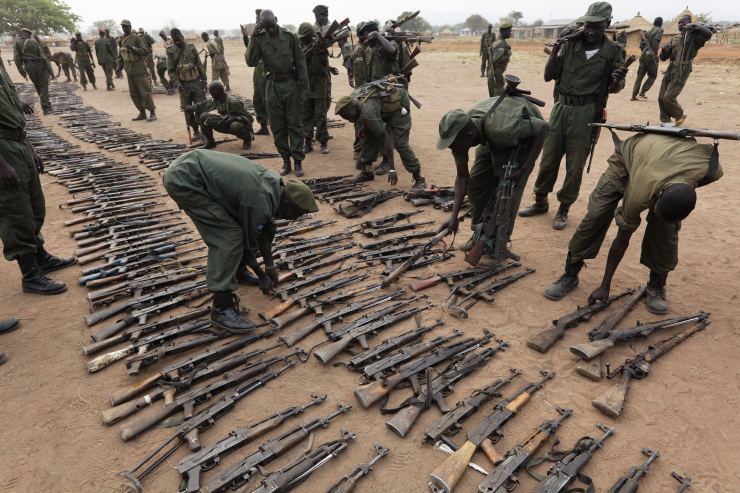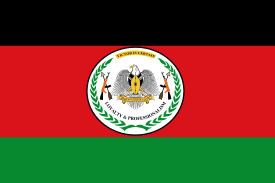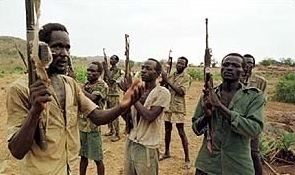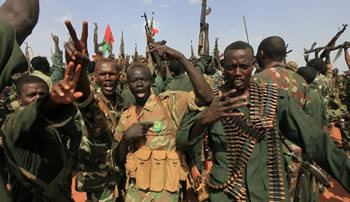Active 1983–present Motto(s) Victory is certain | Size 150,000 (2015) Commander-in-Chief Salva Kiir Mayardit | |
 | ||
Country Sudan (1983–2011) South Sudan (2011–present) Branch Sudan People's Liberation ArmySouth Sudan Air Force Founders Salva Kiir Mayardit, John Garang Engagements Second Sudanese Civil War, South Sudanese Civil War, Heglig Crisis, Battle of Malakal Similar Sudanese Armed Forces, Uganda People's Defence, Ethiopian National Defense, Sudanese Air Force, Armed Forces of the Demo | ||
The Sudan People's Liberation Army (SPLA) is the army of the Republic of South Sudan. The SPLA was founded as a guerrilla movement in 1983 and was a key participant of the Second Sudanese Civil War. Throughout the war, it was led by John Garang de Mabior.
Contents
- Sudan people s liberation army
- History
- War in the 1980s
- Political openings
- 1991 Setback and split
- Battles of 1992
- Mid 1990s
- 2005 Peace Deal
- Ministry of Defence
- 2013 political crisis
- Current organization
- Equipment
- Defence expenditure
- References

Following John Garang's death in 2005, Salva Kiir was named the new Commander-in-Chief of SPLA. As of 2013, the SPLA was estimated to have 210,000 soldiers, as well as an unknown number of personnel in the small South Sudan Air Force. The SPLA is divided into divisions of 10,000-14,000 soldiers. Following South Sudan's independence in 2011, the SPLA became the new republic's regular army.

Sudan people s liberation army
History

In 1983 a number of mutinies broke out in the barracks of the Sudanese army in the southern regions, most notably in Bor. These mutineers would form the nucleus of SPLA. By June 1983 the majority of mutineers had moved to Ethiopia, or were on their way towards Gambella. The Ethiopian government's decision to support the nascent SPLA was a means of exacting revenge upon the Sudanese government for their support of Eritrean rebels.

SPLA was led by Commander-in-Chief John Garang de Mabior. SPLA struggled for a united and secular Sudanese state. Garang stated that the struggle of the South Sudanese was the same as that of marginalized groups in the north, such as the Nuba and Fur peoples. Until 1985, SPLA directed its public denouncements of the Sudanese government specifically at Nimeiri. During the years that followed, SPLA propaganda denounced the Khartoum government as a family affair that played on sectarian tensions. SPLA denounced the introduction of sharia law in September 1983.
War in the 1980s

In the village of Bilpam, the first full-fledged SPLA battalion graduated in 1984. The name 'Bilpam' would carry a great symbolic importance for SPLA for years to come, as the epicentre of the uprising. After Bilpam, other SPLA training camps were established at Dimma, Bonga and Panyido.

In the mid-1980s the SPLA armed struggle had blocked the development projects of the Sudanese government, such as the Jonglei Canal and the Bentiu Oil Fields.
SPLA launched its first advance in Equatoria in 1985-1986. During this campaign, SPLA were confronted by a number of pro-government militias. The conduct of SPLA forces was chaotic, with many atrocities against the civilian population. The SPLA drove out around 35,000 Ugandan refugees (that had settled in Equatoria since the early 1980s) back into Uganda.
SPLA had a complicated relationship with Anyanya II. Anyanya II forces blocked the expansion of SPLA between 1984 and 1987, as Anyanya II attacked SPLA recruits heading towards the SPLA based in Ethiopia. Anyanya II also attacked civilians believed to be SPLA supporters. The conflict between Anyanya II and SPLA had a political dimension, as Anyanya II sought to build an independent South Sudanese state. SPLA did however try to win over the leaders of Anyanya II to their fold. The Anyanya II commander Gordon Kong Chuol aligned with SPLA in late 1987. Other sectors of Anyanya II would follow his example over the coming years, rendering the remainder of Anyanya II (allied with the Sudanese government) marginalized.
Another force which confronted SPLA were the Murahaleen militias in northern Bahr el-Ghazal. Warfare between SPLA and Muraleheen began in 1987. By 1988 SPLA controlled most of the northern Bahr el-Ghazal. Unlike the Anyanya II, however, the Murahaleen had no political ambitions.
Political openings
SPLA boycotted the 1986 elections. In half of the constituencies of southern Sudan elections could not be held due to the SPLA boycott. In September 1989, the RCC invited different sectors to a 'National Dialogue Conference'. The SPLA refused to attend.
On November 15, 1988 SPLA entered into an alliance with the DUP. The two parties had agreed on the lifting of the state of emergency and abolition of sharia law. The press release was made public through an announcement on Radio SPLA. After DUP rejoined the government, a ceasefire with SPLA was achieved. After the elections, negotiations between SPLA and Sadiq al-Mahdi had been started. But the talks were aborted as SPLA shot down a civilian airplane. 60 people were killed in the attack.
With the NIF coup d'état in 1989, all peace talks ended. SPLA launched a major offensive between 1989 and the fall of the Ethiopian Derg government in 1991. It captured various towns, such as Bor, Waat, Yambio, Kaya, Kajo-Kaji, Nimule, Kapoeta, Torit, Akobo and Nasir. By the middle of 1991, SPLA controlled most parts of southern Sudan with the exception of the major garrison towns (Juba, Yei, Malakal and Wau) Between January 21 and January 29, 1990 SPLA shelled Juba town. SPLA forces also moved into the Nuba Mountains and the southern parts of the Blue Nile State. In comparison with its 1985-1986 offensive in Equatoria, the conduct of SPLA was now more orderly.
1991: Setback and split
But the downfall of the Derg government in Ethiopia in May 1991 caused a major set-back. The Ethiopian government had provided the SPLA with military supplies, training facilities and safe-haven for bases during 18 years. Soon after the change of government in Ethiopia, SPLA accompanied hundreds of thousands of refugees back into Sudan.
A split in SPLA had simmered since late 1990, as Lam Akol and Riek Machar began to question Garang's leadership. Lam Akol began secretly contacting SPLA officers to join his side, especially amongst the Nuer people and Shilluk people. The situation deteriorated after the fall of the Derg. As the Derg regime crumbled, Lam Akol published a document titled Why Garang Must Go Now. The split was made public on August 28, 1991 in what became known as the Nasir Declaration. The dissidents called for democratization of SPLA and a stop to human rights abuses. Moreover, the dissidents called for an independent South Sudan (in contrast to the SPLA line of creating a united and secular Sudan). Kong Coul joined the rebellion. The 'SPLA-Nasir' was joined by the SPLA forces in Ayod, Waat, Adok, Abwong, Ler and Akobo. A period of chaos reigned inside SPLA, as it was not clear which units sided with Garang and which units sided with SPLA-Nasir.
Garang issued a statement through the SPLA radio communications system, denouncing the coup. Nine out of eleven (excluding himself) SPLA/M PMHC members sided with Garang. The mainstream SPLA led by John Garang was based in Torit. The two SPLA factions fought each other, including attacks on civilians in the home turf of their opponents.
Battles of 1992
As of 1992 the Sudanese government launched a major offensive against SPLA, which was weakened by the split with SPLA-Nasir. SPLA lost control of Torit (where SPLA was headquartered), Bor, Yirol, Pibor, Pochalla and Kapoeta.
SPLA made two attacks on Juba in June–July 1992. SPLA nearly captured the town. After the attacks, the Sudanese government forces committed harsh reprisals against the civilian population. Summary executions of suspected SPLA collaborators were carried out. On September 27, 1992 the deputy commander-in-chief of SPLA, William Nyuon, defected and took a section of fighters with him. SPLA re-captured Bor on November 29, 1991.
Mid-1990s
As of the mid-1990s, the majority of the population of Southern Sudan lived in areas under the control of either the mainstream SPLA or SPLA-Nasir.
2005 Peace Deal
In 2004, a year before the peace deal, the Coalition to Stop Child Soldiers, estimated that there were between 2,500 and 5,000 children serving in the SPLA.
Following the signing of the CPA, a transformation process of SPLA began. This process was actively supported through funding from the United States. In 2005, John Garang restructured the top leadership of SPLA, with a Chief of General Staff, Lt. Gen. Oyay Deng Ajak, and four Deputy Chiefs of General Staff; Maj. Gen. Salva Mathok Gengdit (Administration), Maj. Gen. Bior Ajang Aswad (Operations), Maj. Gen. James Hoth Mai (Logistics) and Maj. Gen. Obuto Mamur Mete (Political and Moral Orientation).
Ministry of Defence
In 2007, the SPLA was further organised into the Ministry of Defence. Gen. Dominic Dim Deng an SPLA veteran and distinguished General, was chosen to become the first Minister for SPLA Affairs subsequently the first political officer of the SPLA. Gen. Dim died in a plane crash in 2008 alongside his wife Madam Josephine Apieu Jenaro Aken and other SPLA officers. He is buried alongside his wife at the SPLA headquarters in Bilpham, Juba.
Deputy Chief of Staff (Logistics) James Hoth Mai replaced Oyay Deng Ajak as Chief of General Staff in May 2009.
In 2010 U.S. diplomats reported that Samora "made a point to discuss how the SPLA needed to be reorganized. He stated that the SPLA was top heavy, carrying nearly 550 general officers and providing more than 200 security guards for each minister."
The Government of Southern Sudan named the SPLA headquarters outside Juba 'Bilpam'.
Work on a national security strategy began in late 2012.
2013 political crisis
On December 15, 2013, fighting broke out in Juba between different factions of the armed forces in what the South Sudanese government has described as a coup d'état. President Salva Kiir announced that the attempt was put down the next day, but fighting resumed December 16. Military spokesman Colonel Philip Aguer said that some military installations had been attacked from armed soldiers but that "the army is in full control of Juba." He added that an investigation was under way and that though the situation was tense it was also unlikely to deteriorate.
Current organization
The SPLA is operationally commanded by the Chief of General Staff (COGS). The COGS oversees five directorates, each led by a deputy chief of general staff (DCOGS):
The SPLA currently has nine divisions and a small air force, all of which report to the DCOGS, Operations:
Per a 2015 security agreement with the Sudan People's Liberation Movement-in-Opposition, military forces currently stationed in Juba, Bor and Malakal are to be moved to bases at least 25 kilometers outside of each respective city. The Presidential Guard at Giada Barracks and SPLA's General Headquarters in Bilpam are authorized exceptions to the agreement.
Equipment
As of 2013 the SLPA's land forces operated the following heavy equipment:
As of 2013 the South Sudan Air Force operated the following aircraft:
Defence expenditure
According to the 2013 edition of the International Institute for Strategic Studies' report The Military Balance, South Sudan's defence budgets since 2011 have been as follows:
